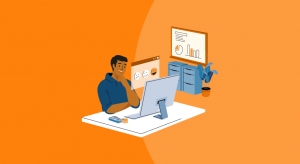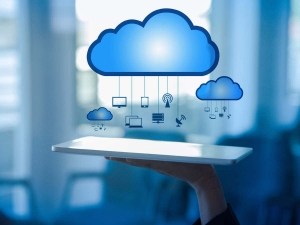عرض العناصر حسب علامة : السحابة الالكترونية
بناء وظيفة مالية مناسبة للمستقبل
بالنسبة للعديد من الشركات، يمكن أن يكون نظامها المالي عائقًا أمام النمو. إن الحصول على الأفكار التي تحتاجها لاتخاذ قرارات عمل ناجحة أمر صعب ويستغرق وقتًا طويلاً.
معلومات إضافية
- البلد عالمي
- نوع الفعالية مجانا
- بداية الفعالية الخميس, 27 أكتوبر 2022
- نهاية الفعالية الخميس, 27 أكتوبر 2022
- التخصص محاسبة ومراجعة
- مكان الفعالية اونلاين
كيف يغير الذكاء الاصطناعي بشكل أساسي سير عمل شركات المحاسبة
يعد استيعاب الكثير من المعلومات مشكلة لا تنتهي بالنسبة لشركات المحاسبة من مواكبة التدفق المستمر لبيانات العملاء والامتثال والاتجاهات التنظيمية، فضلاً عن الاتجاهات الناشئة في التكنولوجيا والابتكارات الأخرى
معلومات إضافية
-
المحتوى بالإنجليزية
Assimilating information is a never-ending battle for your accounting firms. From keeping up with the constant flood of client data, compliance and regulatory trends, as well as emerging trends in technology and other innovations, the struggle is real.
While no one will argue that investing time and energy into constant monitoring and responding to changes in client data, compliance, and regulatory information isn’t vital, the importance of understanding and responding to technology trends can sometimes be overlooked. However, it is information from emerging solutions that can give your firm the edge when it comes to effectively streamlining and better leveraging the data that is coming into your firm.
There are two key tech trends which, by now, should be on the radar and minds of every accounting leader: migration to cloud-based technology and the adoption of solutions utilizing artificial intelligence (AI). This is because they both, more than any other recent technology have had—and continue to have—profoundly positive and far-reaching effects on the accounting profession.
While much has been written about “getting into the cloud” and a large percentage of accounting firms are working at least partially in it, using web-based platforms to run part of their practice operations. They do so, in tandem or perhaps ahead of their business clients, many of whom are transitioning to the cloud.
The research and consulting firm Gartner names cloud computing “one of the most disruptive forces of IT spending” and attributes its influence through 2020 on more than $1 trillion in technology spending. This trend is expected to continue for at least the next decade.
In contrast, AI is still a term which seems foreign to many accounting professionals, even though the technologies that it encompasses such as machine learning and OCR have been widely used for years. If the idea of AI still conjures up images of futuristic applications which may never become practical for your firm, it is important to shift your mindset in order to be prepared for the future benefit these technologies can bring your firm.
For example, AI technologies can eliminate many of your firm’s administrative and repetitive task workflows given its ability to make it possible for machines to learn from experience, adjust to new information, and use it to accomplish human-like tasks. Some applications you may already be using which incorporate AI include expense management and accounts payable platforms.
AI also makes it possible for large volumes of data to be processed and analyzed quickly, freeing up staff to do more value-added engagements. A recent study by Big Four firm PwC reported that 72 percent of business decision-makers believe that using technologies with AI lets their employees focus on more meaningful and creative work.
In addition to speed and agility when processing information, and increasing the availability of strategic insights from the information extracted, AI also adds additional security for the storage of sensitive financial data. This is another significant reason that this particular development will continue to grow in importance across the profession.
3 طرق يمكن للبرامج أن تحسن بها اتصالاتك مع العميل
تتيح برامج التقارير المرئية للمحاسبين القانونيين التواصل بشكل أكثر فعالية مع العملاء حيث يمكن أن تظهر الشركات بالتفصيل وضعها المالي وأين تتجه.
معلومات إضافية
-
المحتوى بالإنجليزية
3 Ways Software Can Improve CPA-Client Communication
Visual reporting software enables CPAs to communicate more effectively with clients. CPAs can show businesses in detail their financial status and where they are headed.
CPAs are skilled in analyzing financial data and determining how it impacts the clients they serve. While this financial prowess is a valuable tool for businesses, effective communication is a skill that is equally important. Communication is so essential that 97 percent of employers said soft skills like communication were as important or more so than hard skills.
While good communication is a key skill for CPAs, it does not always come naturally. It is often something that must be developed and worked on consistently. Luckily, in this day and age, there is often a technological tool to help. Along with working on interpersonal communication tactics, CPAs can take advantage of software to improve communication with clients.
Be More Accessible
Sometimes, the biggest hindrance to communication is the availability of a CPA when a client comes calling. CPAs can utilize technology to ensure they are accessible to their clients and their relationship of trust is not compromised by being hard to reach. CPAs do not need to be at a client’s beck and call 24 hours a day, seven days a week. However, making the effort to talk to clients regularly—even checking in outside normal hours—lets them know their CPA is a trusted member of their team.
The COVID-19 pandemic ushered in a sudden need to communicate from afar—and it showcased technology that makes it possible. CPAs can use video conferencing software to conduct virtual meetings from anywhere in the world. Firms can also put Voice Over Internet Protocol software to use, allowing CPAs to use a secure phone line from anywhere to communicate with clients while protecting their data. Using these software options ensures CPAs can be there for their clients when they need them most.
Give Instant Feedback
When clients have questions or concerns, they want to know their CPA is on the ball and ready to assist them. Great communicators are quick to respond and provide feedback, reassuring clients that they are in good hands. Enter cloud-based software that can give near instantaneous results and act as a conduit between clients and their CPAs. Recent research showed that companies using cloud accounting software exclusively saw 15 percent growth year over year. Better communication with clients is no small part of this success.
Using cloud-based software allows CPAs to be more responsive to their clients and communicate quickly and accurately. Using the cloud to enter data and deliver analysis to clients gives them answers right away, and dashboards allow clients to see their financial performance in real time. Often, when clients have questions for their CPA, dashboards can be configured on the spot to show them what they need to know. CPAs can communicate rapid responses and accurate results for their clients with cloud software.
Provide Clearer Information
Have you ever had a conversation with a client, then felt as though your insights and advice fell on deaf ears? It’s quite possible that your analysis of the client’s financial data didn’t have the impact you hoped, but it may not be because your client didn’t want to hear it. Talking with clients is important, but people don’t always fully retain the information they hear. One study found that as many as 80 percent of people are visual learners, when compared to auditory learning. Your clients are much more likely to hang on to your every word when your advice comes with visuals.
CPAs provide their clients with valuable financial information, and good communication means ensuring clients understand that information. Visual reporting software enables CPAs to communicate more effectively with clients. CPAs can show businesses in detail their financial status and where they are headed. This software allows CPAs to explain their analysis more clearly, while clients are also more likely to retain and utilize the data for the benefit of their businesses.
CPAs must be good communicators as they build relationships with their clients and provide invaluable financial analysis and advice. This software and others can help CPAs improve their communication with clients as trusted advisors.
اتجاهات التكنولوجيا القائمة على السحابة في شركات المحاسبة
المتطلبات التنظيمية المتطورة هي مجرد جزء من المعادلة عندما يتعلق الأمر باتجاهات الصناعة الناشئة التي تؤثر على مهنة المحاسبة.
معلومات إضافية
-
المحتوى بالإنجليزية
The Three Emerging Cloud-based Technology Trends Transforming Accounting Firms
Evolving regulatory requirements are just part of the equation when it comes the emerging industry trends impacting the accounting profession. Technology and the ongoing innovations in cloud-based solutions are likely to be one of the most transformative forces in your practice over the next three-to-five years.
Research firm Gartner estimates that by 2024 more than 45% of IT spending will shift to cloud-based technologies, and in many instances, this will include accounting software—driving the demand for accountants with strong cloud accounting software skills.
Key to the changing technology landscape for accounting firms is the introduction of new tools with real-time data analytics and artificial intelligence (AI). To thrive in this new technological ecosystem, accounting firms will need to have a clean, reliable, and secure data infrastructure. This may present a challenge for firms that have legacy on-premises systems, not only from a cybersecurity and workflow standpoint, but also in terms of revenue.
This is because it is only by using a new breed of cloud-based accounting systems that firms can open the door to automated financial reporting, cash management, accounts payable, and month-end close processes. The automation of these tasks will increase your firm’s productivity and profitability.
With this in mind, here is a closer look at the three technologies poised to have a lasting impact on the accounting profession: AI, analytics and cybersecurity.
1. Artificial intelligence. Once considered a futuristic technology, AI is now considered by many to be mainstream. There is a growing consensus that AI can and will have a significant impact on just about every industry and business role.
Accounting firms and their clients are already implementing solutions featuring AI to automate mundane, easily repeatable tasks, freeing employees and firm owners to focus their time on higher-value activities.
How will AI impact your firm? Consider this example: using machine learning, a type of AI, a company can feed a year’s worth of expense reports into a travel and expense system with the goal of teaching it to flag anomalies that might indicate fraud or human error. The more reports the system has to study, and the more time it spends analyzing them, the better it becomes at identifying potential issues, creating the opportunity for time and cost savings.
2. Analytics. One of the key advantages of cloud-based technologies incorporating AI and machine learning is the advanced analytics capabilities they offer for users. When more data can be analyzed more quickly with advanced reporting tools, the output is richer and offers deeper insights. This allows accountants to not only save time and increase productivity on data processing functions, but also provides the opportunity to offer additional advisory services and add more value to client relationships.
3. Cybersecurity. Using cloud-based technologies is often more secure than on-premises versions because the right vendor will store all of the client and other data your team has stored in accordance with leading cybersecurity practices most businesses cannot match on their own. In addition, the technology provider will update your solutions frequently in response to emerging security threats. This provides peace of mind to your clients and mitigates liabilities for your firm. Cloud systems also provide the redundancy necessary for business continuity should you need to relocate your firm, work remotely, or face some other business disruption.
It is now a fact: cloud-based technology innovations are disrupting the accounting industry. This trend is quickly transforming what used to seem like futuristic applications and use cases into mainstream solutions. Over the next few years, the technologies described above, along with other developments, will help accountants increase the efficiency of their workflows, access richer data, securely serve their clients, and extract additional insights from every accounting process. The only remaining question is, how will your firm respond?
كيفية اختيار برنامج المحاسبة المناسب لعملك
ربما تفكر في شراء برنامج محاسبة لأول مرة او تفكر في تبديل البرنامج الذي تستخدمه حالياَ في مرحلة ما، قد تتساءل عن كيفية اختيار برنامج المحاسبة المناسب هناك العديد من الخيارات المتاحة امامك ولكن قد تشعر انك لا تعلم اي منها المناسب لك.
معلومات إضافية
-
المحتوى بالإنجليزية
Maybe you’re thinking about buying accounting software for the first time. Or, you’re finally ready to switch software providers. At some point, you may wonder how to choose accounting software. There are so many options out there that even knowing where to get started selecting the right accounting software can feel impossible. This article will help you learn how to choose accounting software that fits your needs.
How to choose the right accounting software for your business
How to choose the right accounting software for your small business can make your head spin. Your company has specific needs. And with so many software features, price points, commitment timelines (one-time charge or subscription), and everything else, it can be tough to keep things straight.
To sort through your options, consider the following five tips.
1. Choose accounting software that fits your budget
Before you get started, you should know the cost of accounting software varies. The amount often increases with the number of features the software provides. Want more features? You may have to shell out some more money.
It’s important to understand how the price compares to available features when choosing accounting software. The last thing you want is overpriced software with a bunch of features you’ll never use. Check and see if the software offers a free trial or self-guided demo before purchasing. If they do, you’ll get to know the software’s features before you commit.
Watch out for how you are charged for the software. Software companies often have different methods for charging users. Some software applications are sold at a large, one-time fee. Depending on the software, you might have to pay additional expenses for updates when they come up. If this is the case, you won’t be able to plan ahead of time for the new fee. If the update is needed, you’ll need to pay for it.
Other software programs work on a monthly or yearly subscription. They are often sold in packages with a tiered pricing structure that allows you to choose exactly what you need. If you choose software that charges a monthly fee, know the terms before subscribing.
Make sure that you understand your contract—is it flexible or iron-clad? If you break a contract, you could be charged a fee.
Last but not least: watch out for the hidden or additional fees. You don’t want to be surprised by extra charges for creating invoices, running reports, providing setup, customer service, and data storage.
2. The best accounting software is the one you know how to use
If you’re like many small business owners, you have a depth of knowledge in your specific field, not accounting. You don’t want to spend your workweek learning bookkeeping.
Sure, you might not technically be a bookkeeper, but you aren’t new to money management. You’ve been managing your finances ever since you first debated whether or not you should break your piggy bank or fill it up some more.
With that being said, accounting software comes with all different types of skill levels in mind. Some are simple and made for the nonaccountant. Others are more suited for accountants. In the end, it doesn’t matter who you are. You should look for software that offers free resources and customer support. That way, if you do need to learn something new, there’s an easy way to make sure you have the right information.
3. Decide the features you need for accounting software
The good thing about having so many features to choose from is that you get to find the accounting software that fits your needs like a glove.
Here are some common features you might come across:
Create and track invoices
Pay vendors
Compile financial statements
Process credit cards
Integrate with bank accounts
Record customer histories
We all love a good checklist. To help organize your search, make a checklist of all the features you need. Prioritize the list from the most necessary features to the least.
Find a software solution that supports both current needs and future needs. Find software that can grow with your business.
4. On-the-go owners must look for flexibility
If you find yourself loosely defining the word “office” to include cafes, airport lounges, and your favorite restaurant, you may want to look into cloud-based accounting software.
Cloud-based software stores information online so you can access the program anywhere with any device connected to the internet. There are a lot of upsides here: You aren’t tethered to a desk, and you don’t have to worry about losing accounting information if your computer crashes on you.
If you do choose desktop software, you should know the risks. That single computer and its hard drive become the center point of your workweek. And, the software is only available to you if your computer is in tip-top shape. Crashes, water damage, and power outages can wreak havoc on your accounting records.
5. Make sure that quality customer support is there when you need it
You may have questions or need help understanding your new software. And when that time comes, you’ll want a support team that can help quickly and easily. Quality customer support that is knowledgable and easy to get a hold of will be key to switching over to new software.
Here are some questions to keep in mind when thinking about customer support:
Is the support free, or are there additional, even recurring fees?
What time zone are they in? Make sure you don’t lose too much time between different time zones.
Is the support team experienced and knowledgeable about the software and your needs?
Is there more than one way to get ahold of customer support (e.g., phone, email, online chat)?
How to choose accounting software
The items listed above are just a starting point. You also need to consider the following:
Reports: Look for easy-to-read reports that are shareable with your accountant, managers, or other trusted employees.
Accounting method: Choose accounting software that matches your preferred accounting method.
Security: Make sure that the software has your security interests in mind.
Commitment: Choose month-to-month or annual commitments (whichever fits your needs).
Reviews: Trust customers who’ve been using the software for weeks, months, and even years—let them tell you just how good the software is.
ما هو امن الحوسبة السحابية Cloud Computing Security
مع تطور الطريقة التي تعمل بها المؤسسات، تطورت كذلك طبيعة التهديدات التي تواجهها الشركات. وعلى الرغم من أن فوائد الحوسبة السحابية ضخمة، إلا أنها تأتي مع مجموعة المخاطر الخاصة بها.
معلومات إضافية
-
المحتوى بالإنجليزية
What is Cloud Computing Security?
Cloud computing security, or cloud security, is the combination of policies, controls, technologies, and applications employed to protect your cloud environment.
These sets of security measures are aimed at protecting your data, applications, and cloud infrastructure from internal and external threats. Additionally, protecting users’ privacy and automatically maintaining compliance with industry-specific regulations are also taken care of.
Cloud Computing security has three essential components.
Prevention Measures
Preventive measures, such as firewalls and anti-malware software, minimize vulnerability. They create a fort-like protective environment for cloud data, assets, and users. The system is protected from unauthorized users via multi-factor authentication.
Detection Measures
These monitoring and analytical measures are aimed at locating and stopping in-progress threats. Depending on the nature of the threat, measures are deployed to eliminate the attack. Several cloud security set-ups also use intelligent threat hunting and predictive technologies to create proactive solutions.
Correction Measures
These controls are focused on damage control and remediation actions after an attack has occurred or while it’s in progress.
Why do you need Cloud Computing Security?
Businesses administrators are concerned about moving their data to the cloud. And why wouldn’t they be? We hear of sophisticated malware and phishing attacks constantly, which is scary.
Sensitive business information is the lifeline of a business and, therefore, a target for malicious forces. A survey by Ermetic reports that nearly 80% of companies working on the cloud experienced a data breach at some time or another.
Even though cyber-hacks and attacks can be trending topics, the fact is that your data is much safer on the cloud. Security and data protection are high priorities for cloud service providers.
Protection of users’ identity, information, and privacy is the cornerstone of cloud computing security. Additionally, cloud computing security focuses on preventing leaks, controlling data access, preventing attacks, and providing real-time statistical analysis of penetration attempts.
Benefits of Cloud Computing Security
1. Centralized security
Cloud computing security centralizes all security protocols in one place. Companies that operate in cloud-based networks deal with various devices and endpoints, and it is a humongous task to keep a check on shadow IT or various personal devices.
With cloud-based central management, all web traffic can be analyzed. Software and security policy updates can be made at once, and disaster recovery plans can be implemented evenly and quickly.
2. Cost efficiency
Cloud security eliminates many overhead costs that businesses have traditionally incurred. The capital investment on expensive hardware and its maintenance is eliminated with cloud services. Additionally, you receive a team of security experts working for you instead of hiring and training new employees.
3. Reliable and readily available
Cloud security measures, once effectively in place, offer solid reliability. They provide consistent safety when accessing the cloud from anywhere. They are also readily available, so you don’t have to wait for hardware delivery and set-up before starting.
4. Reduced IT and admin workload
Cloud computing security is centralized and automated. It frees up your IT and admin teams from several repetitive tasks, such as making manual updates or implementing policies across all devices.
5. Compliant with industry regulation
Effective cloud computing security programs generate reports that adhere to compliances such as HIPPA, PCI DSS, ISO 27002, to name a few. Such automatic compliance goes a long way in making work more convenient.
6. Ease of scaling
Your security can easily and instantly scale with your cloud computing demands and integrate changes quickly without security risks. Cloud security also has the ability to scale up during high traffic periods and scale down during low traffic periods.
Essential Functions Performed by Cloud Computing Security
Cloud computing security in itself is an umbrella term. It encompasses all the security practices and technologies employed in protecting an organization’s cloud environment.
On a case-by-case basis, the components and functions of cloud security vary in enterprises. It depends on an organization’s security strategy, industry-specific requirements, risk and vulnerability assessments. But some components are generally found across different strategies and are an essential function in providing cloud computing security.
1. Access control for sensitive data
Access and identity management is an essential task, where access to critical data is limited to essential personnel. It includes determining who can take which action on file, such as who has permission to edit a file versus who can only read it.
2. Protection from social engineering threats
Social engineering attacks, such as phishing, capitalize on human errors. Awareness training for employees helps them be vigilant and smart when working on the cloud.
3. Data backups and disaster recovery
We’ve all forgotten to save our work at some time or the other. Cloud security software backs-up data automatically and at regular intervals. With data saved in remote servers, data safety during disasters is ensured.
4. Anti-malware and ransomware
Anti-malware, anti-virus, and protection from ransomware are core components of all security strategies. All endpoint devices are protected with the use of firewalls, URL filtering, and several other measures.
5. Event analysis and monitoring
An essential feature of a comprehensive security strategy needs real-time monitoring and detection of threats and attacks. Regular event reports are analyzed for enhanced risk and vulnerability assessment and threat prediction.
Cloud Computing Security – A need of the hour
Cloud computing security goes a step beyond just protecting your data; it protects your users’ privacy while reducing costs and easing the load off your IT and administrative teams. In the age of cloud computing, your security strategies cannot be traditional. They need to be cloud-based too!
أولى خطوات الأمن المالي للمحاسبة الآمنة
توفر التكنولوجيا القائمة على السحابة فرصًا ومخاطر على حد سواء للشركات، ولكنها أيضًا تشكل خطرًا. مع تزايد اتجاهات القرصنة وسرقة البيانات، أصبح نظام المحاسبة الآمن أكثر أهمية بالنسبة للمهام. دعنا نستكشف خطوات الأمان المالي الأولى التي تحتاج إلى اتخاذها مع نظام المحاسبة الخاص بك.
معلومات إضافية
-
المحتوى بالإنجليزية
Cloud-based technology offers both opportunities and dangers for businesses, but also danger. As hacking and data theft trends rise, a secure accounting system is even more mission-critical. Let’s explore the first financial security steps you need to take with your accounting system.
FIRST FINANCIAL SECURITY
First Financial security Steps you Need to Take
These are serious threats to your company’s, even customers’ financial security and data. However, you can prevent them with an effective plan and accounting system. To help, here are the first financial security steps you should take.
1. Know your threats
The threats outlined above are the overarching threats all modern companies face. However, your individual company faces these threats, as well as unique threats depending on your operation and industry. Be granular with your threat assessments. This will help you pinpoint what kind of functionalities you need in place to keep you secure.
2. Know your regulations
Some of your security threats may be covered within business regulations you must follow. These regulations protect you, your customers, and ensure proper accounting standards. Some industries are more heavily regulated in accounting security and reporting regulations, including Government contractors and nonprofits. Review your industry regulations to incorporate them with your other financial security needs.
3. Establish security requirements
Work with your team to identify risk factors to create a comprehensive financial security requirements list. As you collaborate, internal controls should be considered too. These play a big role in defining additional functionality you need from an accounting system.
4. Choose for the right accounting system
You’ve established financial security requirements, now you need a secure accounting system. The reality is that basic accounting security features like usernames and passwords aren’t enough anymore. Most accounting apps lack in-depth internal security features or are restrictive in their deployment. You’ll need to be able to tailor the security requirements and processes to your specific needs.
Next Steps: Choosing an Accounting Solution
The first financial security steps will likely lead you to invest in a more flexible, secure accounting solution. To help, be sure to check out our free 2020 Accounting Technology Buyer’s Guide. You’ll get details on critical accounting security features alongside other valuable features for an efficient and reliable accounting system.
رسالة ماجستير: أثر استخدام الحوسبة السحابية على جودة المعلومات المحاسبية وانعكاسها على تطوير معايير التقارير المالية الدولية
تعد الحوسبة السحابية بمثابة نقلة نوعية في عالم التکنولوجيا وهي تعتمد على نقل المعالجات ومساحات التخزين الخاصة بالحاسب الى ما يعرف بالسحابة
معلومات إضافية
- البلد مصر
ما هو الأمن السيبراني المحاسبي
معلومات إضافية
-
المحتوى بالإنجليزية
Accounting cybersecurity is a growing issue. Financial data, in particular, is a prime target for hackers and data theft efforts, making this a nightmare for accounting professionals and businesses alike. As a result, IT teams and accountants must consider how to keep precious data secure.
In this article, we look at how accountants can structure an accounting cybersecurity strategy to keep financial data secure. Above all, we discuss tips to keep financial data secure and champion dual cyber security and accounting best practices throughout your organization. Also, we examine cloud-based accounting software features that keep data safe and secure.
cybersecurity blog accounting seed
Why Accounting Cybersecurity Needs To Be Top-Of-Mind
While the cloud has made accounting easier to access and manage, it’s also opened up many more threats than conventional paper-pen bookwork. To clarify, even robust IT infrastructures can be targeted and penetrated by hackers and cybercriminals. But, what’s even more disheartening and dangerous is that internal accounting data threats are even more costly.
Some think that cyber security and data security are not linked to the accounting life cycle. This isn’t true. For example, besides hacking, financial data threats can include errors and unintentional data breach that necessitates sophisticated solutions to safeguard data. Accountants and accounting firms know that financial data breaches threaten livelihood, business growth, customer relations, and more. Similarly, the same account details you use to track debits and credits are vulnerable to malware and malicious activity.
Stolen accounting data can include:
Account numbers
Transaction details
Credit card numbers
Bank accounts
Usernames
Passwords
Personal and private information
Most importantly, the biggest danger is assuming that ‘my accounting firm’ or ‘my company’s financial data’ isn’t threatened. Data breaches in the financial services industry, and in general, are on the rise.
The State Of Accounting Cybersecurity Attacks 2021
2020 saw a major shift to remote workstyles due to the COVID-19 pandemic, but an equal plague is the rise of cyberattacks. For instance, this year the total number of data breaches surpassed 2020 by 17%. In fact, 1,291 breaches occurred in 2021, compared to 1,108 in 2020. This increase shows a significant rise in cyber attacks that have grown more sophisticated with the rise in cybersecurity measures.
How does one account for the cost of these data breaches? First, here’s a snapshot of the years leading up to 2020:
cybersecurity blog accounting seed
Currently, the average cost of data breach for companies is $4.24M, the highest in 17 years. For businesses and accounting firms alike, the mere risk of such a loss is extreme. More importantly, a companies’ reputation can also face immense backlash, even resulting in it having to close. These stories are not rare by any means.
Examples Of Accounting Cybersecurity Breaches
Sequoia Capital (2021)
Financial institutions like Sequoia Capital are often the targets of criminals seeking to hack financial data. This example was not as severe as it could have been, only one employee’s email was successfully hacked through a “wire diversion scam.”In fact, just one data breach can jeopardize customer and business financial data resulting in significant financial loss. Even more, Sequoia had to deal with informing customers and potential investors.
Capital One Data Breach (2019)
This is a prime example of how unguarded internal accounting processes can cause major damage to a company. One of Capital One’s own employees illegally accessed one of the Amazon Web Servers storing vital data and stole 100 million credit card applications. As a result, approximately 140,000 social security numbers were leaked, as well as 80,000 bank account numbers.
What About Small Business Data Breach?
You may think criminals only want to hack the financial data of enterprise size or large businesses? Not true. Small to medium-sized businesses are prime targets too, only the consequences can be more devastating. According to an Inc. article, 60% of small businesses fail within six months of a cyber attack.
Even if a business doesn’t close, the costs of a data breach can be immense. For example, an Oregon-based accounting firm, Gustafson & Co, experienced a massive data breach and was forced to pay $50K after 1,900 individuals were exposed.
Cyber Security For Accounting Firms: 6 Essential Practices
There are risks to your financial data both outside of and inside of your organization. Subsequently, it’s not hard to take control and get ahead of these threats. Preventing or at least mitigating data breaches starts with putting the proper protections in place. There is already evidence that with increased awareness of cybercrime and increased security investment, companies can protect themselves effectively. But, this comes with a dual focus on safe practices and technology. Start doing these financial security steps right now!
1. Know Your Threats
As an accountant, you face threats like hacking, ransomware, and phishing scams, but internal threats and errors are just as compromising. Accidental data sharing can occur easily with untrained staff, and there are multiple ways data relevant to the financial lifecycle can be misplaced. It’s critical to analyze how your individual organization handles data and create accountability into your actual accounting practices for proper data management.
2. Train Your Staff
As the accounting profession becomes more intertwined with IT and cloud accounting, protecting financial data will take precedent. Instilling a sense of ownership in financial data is a vital necessity. For instance, do this by educating your team on the growing threats and risks of a financial data breach and how to prevent ransomware attacks. In the same vein, accounting system security is critical not only for your accounting firm and your reputation but also for your customers. Accounting Seed values accounting security so much, we make it our mission to provide resources to help accountants and businesses protect their data. Check out our free guide and webinar.
3. Know Your Regulations
Some of your security threats may be covered within business, state, and federal regulations you must follow. This is especially the case if your accounting firm contracts with the federal government. These regulations protect you, your customers, and ensure proper accounting standards. Document these requirements and incorporate them into your reporting and accounting standards.
4. Design An Approval And Validation System
Your most trusted and experienced managers and approvers must take ownership. Establish which actions and data need to be looked over and approved by higher-level managers. Besides ensuring the most experienced and trustworthy staff members have the final authority on using data, this also helps protect your accounting firm from potential errors. Remember, accidental data sharing is common, and about 80% of data breaches are caused by internal human errors. Constructing an approval and validation system helps ensure no mistakes are made that would jeopardize your data.
5. Establish Security Requirements
Work with your team to identify risk factors to create a comprehensive financial security requirements list. Besides taking in specific accounting practices and regulations, examine your unique process to see where data slips may occur. As you collaborate, internal controls should be considered too. These play a big role in defining additional functionality you need from an accounting system.
6. Choose The Right Accounting System
The most critical step in accounting cybersecurity is choosing the right accounting system. The best plans and established financial security requirements mean nothing if you can’t implement them. Or, if you’re forced to implement these protections manually. The reality is that basic accounting security features like usernames and passwords aren’t enough anymore. To secure your accounting system against current cyber threats and ransomware attacks, you need a flexible system that has both strong encryption and automated internal security functions.
Keep Financial Data Secure With Reliable Accounting Software
Besides helping your accounting firm manage and analyze finances more efficiently and effectively, one of the core uses of accounting software is protecting your financial data. Remember, you’re not just protecting your firm, you’re protecting the identities and data of your clients. Investing in a secure accounting platform isn’t just necessary, it is a vital step to ensuring your company’s sustainability. Not to mention, your customers’ safety and well-being. But what constitutes a secure accounting system?
Three Core Areas Financial Data Security Features:
1. Natural Event Protection
Securing data through the cloud and with backups to ensure natural disasters and physical destruction or malfunction does not expose or lose data. The cloud has helped eliminate a lot of these threats, so make sure your financial data can be stored on the cloud and accessed virtually.
2. External Threat Protection
This refers to protection from hackers trying to hack financial data – your first line of defense. Strong, secure Application Programming Interface (API) is important to ensure the safety of your financial data as you connect it with other applications. Encryption and overall robust IT infrastructure is also critical to keeping hackers out.
3. Internal Threat Protection
This is your second, more intensive layer of defense which protects you from both external and internal intrusions. If an external threat breaks past firewalls or encryptions, they then have to contend with passwords, permissions, and user hierarchy. Things like passwords and usernames are pretty standard protections across various products, but they’re not enough. More in-depth features are needed to create an extra barrier against cyberthreats while also protecting your accounting data against potential internal errors or malicious activity.
Here Are Some Core Features To Look For:
Two-Factor Authentication
Two-factor authentication lets you enable a second level of authentication for every login. You can also implement a two-factor authentication when a user is performing a specific function like examining billing reports or approving expenses.
User Permissions
User permissions let you clearly define what tasks users can perform, approve, and have access to.
Approvals
You can automate specific steps or sequences of events that require an official signoff on a record to ensure accuracy. The signoff can be linked to the desired authority to ensure data is accurate and secure, and that the current process is proceeding correctly.
User Role Hierarchy
Establishing a user hierarchy lets you dictate which specific user(s) can view or change specific components of accounts or records within the system, like reports. Roles determine user access to opportunities, cases, and contacts.
Validation Rules
Validation rules establish standards for recording and handling data. These security measures also ensure that only select users can do a certain process in the system. Based on business logic, validation rules can be set to prevent processes from being completed out of sequence.
Real-Time Event Monitoring
Real-time event monitoring helps you keep track of and monitor standard events in near real-time.
Audit Trail Functionality
Audit trail lets you track changes throughout the financial reconciliation process to maintain accurate, up-to-date information. This also lets you see exactly who is doing what in the general ledger, with project accounting, and every other aspect of the accounting process.
Object/Field Trail Functionality
Object/field trail functionality lets users view and document changes done to an object or a specific record within the object.
Workflow Rules
Workflow rules let you create and automate internal processes and procedural steps in orchestrating key accounting functions. This dictates how data is logged, accessed, processed, and used.
Secure Email Functions
Encrypt and safely send sensitive emails with accounting data involved. In Accounting Seed, you can utilize page layouts and Salesforce permissions to restrict users from viewing attachments too.
LEARN ABOUT ALL THINGS ACCOUNTING CYBERSECURITY IN OUR FREE GUIDE.
Protect Your Accounting Data Right Now With Accounting Seed
Accounting Seed has all the security features you need to fully protect your accounting data from any threats you face on the cloud. Our flexibility also lets you tailor these security features however best suits your individual needs. Keep your accounting data secure and you keep your organization and customers safe too, not to mention happy.
At Accounting Seed we’re focused on removing security concerns to give you the peace of mind to use your accounting data effectively for your organization. Schedule a free demo today to see how our solution protects your data from all the threats of tomorrow, and beyond.
برنامج محاسبة دفتر الأستاذ العام لعملك
يعد دفتر الأستاذ العام أحد ركائز نظام الإدارة المالية لمؤسستك. لقد جعلت برامج المحاسبة المستندة إلى السحابة بالتأكيد محاسبة دفتر الأستاذ العام أسهل بكثير، ولكن فقط مع ميزات البرنامج الصحيحة. دعنا نلقي نظرة سريعة على الأساسيات الكامنة وراء محاسبة دفتر الأستاذ العام ونفحص ميزات البرنامج التي تجعل إدارة هذه العملية أمرًا في غاية السهولة.
معلومات إضافية
-
المحتوى بالإنجليزية
What is a General Ledger?
To review, the general ledger is the database that contains all of the business transactions of the organization. The transactions are listed in the chart of accounts where they’re grouped based on their type: assets, equity, liabilities, expenses, and revenue. These transactions are closed out and a trial balance is created to report each account’s balance. This is what’s used to develop financial statements.
The general ledger is crucial for ongoing business performance analysis because it provides a comprehensive record of all business financial activities. It’s important to maintain this data accuracy as much as possible through efficient accounting.
General Ledger Accounting: The Basics
General ledger accounting relies on the double-entry method to record transactions. This means that all transactions are posted at least two times in order to account for and balance the effect of each transaction.
For example, when a company gains a loan of $5K the cash of the company increases, therefore an asset entry of $5K is created. But simultaneously, a liability transaction is also created. This is because the loan must be paid off. To account for the repayment of the loan, the cash entry also creates a debit and credit entry.
This lets you visualize the precise effects of all your company’s activities. At the same time, this helps maintain the accuracy of what you’re reporting since transactions are listed twice. You then balance your finances by cross-examining the various entries generated by the single transaction.
General Ledger Accounting Software for Your Business
When it comes to managing your general ledger accounting effectively, your choice of software plays a major role. Here’s what features to look for:
You’ll want to invest in software that’s flexible, letting you easily adapt your general ledger to new requirements without coding. Being able to configure your system for adjustments rather than having to use code is much faster and easier.
Your accounting software should also have a flexible tagging system for your general ledger. This lets you organize your ledger in a way that makes sense for your company’s operations and financial needs.
Validating data entries in the general ledger is much easier and more accurate with a collaborative accounting system. Through increased visibility over company data, you and your team can pinpoint errors and validate correct amounts as an efficient unit.
Robust reporting features are also important for general ledger accounting. Isolating and reporting on specific entries and accounts helps you truly understand what is driving financial data. This also eliminates guesswork and provides definitive information needed to make the best business decisions possible.
Ensure general ledger accuracy with an accounting system that is connected to the source transactions – applications that initiate transactions. Manually logging each entry into the accounting system is time-consuming. It also opens your ledger up to potential human errors. Generating a transaction that automatically creates the entries in your general ledger saves time and maintains data accuracy between operations and accounting systems. For example, with Salesforce, you can create an order with one application on the platform and generate a ledger entry automatically with a native accounting software like Accounting Seed.










